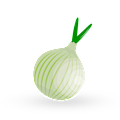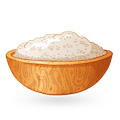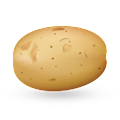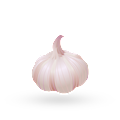Kubbah ḥāmḍa is a Syrian specialty made with stuffed meatballs cooked in a broth flavored with fresh lemon or lime juice. The meatballs, called kubbah, usually consist of lean ground lamb or beef, ground rice, and onions. They are filled with a mixture of spiced ground lamb or beef and parsley or celery leaves.
The stuffed meatballs are then thrown into a broth containing potatoes, carrots, onions, yellow squash or zucchini, celery stalks, garlic, mint, and lemon or lime juice. Delicately sour and flavor-packed, this meatball soup is consumed hot and it has been traditionally prepared for Passover, usually served as an appetizer preceding the Seder meal.
OTHER VARIATIONS OF Kibbeh
Awameh is a sweet Syrian dish consisting of small balls of dough which are fried in hot oil and soaked in honey, cinnamon, or sugar syrup. Sometimes, awameh is sprinkled with sesame seeds. The name of the dish means floater in Arabic, referring to the way the balls float on the surface while being fried.
MAIN INGREDIENTS
Barazek is a delicious cookie from Syria, made of dough from flour, ghee, and sugar, covered with roasted sesame and a bit of pistachio. It is served on holidays as a luxury dessert and is one of the most famous Syrian sweets, particularly during Eid.
The traditional Levantine rice pudding called meghli is a vegan, gluten, and dairy-free dish that is traditionally consumed to celebrate the birth of a baby. It is also said that the brown color of the spiced pudding is symbolic for the richness of soil, while the rough texture of the nuts on top represents growing seeds.
In addition to those symbolic meanings, the caraway in the pudding is thought to assist new mothers with lactation and bloat reduction. Meghli is made with rice flour, caraway, water, sugar, spices, a variety of nuts and spices, and is then cooked over low heat until the mixture can hold itself when tilted.
A variation on Levantine fatteh, fattet hummus typically consists of toasted or fried pieces of pita bread and chickpeas that have been layered in a serving dish before being drenched in a garlicky tahini-yogurt sauce.
This specialty is usually garnished with toasted pine nuts or almonds, fresh parsley or mint leaves, a drizzle of olive oil, and a touch of paprika or cayenne pepper on top. Some versions call for soaking the bread in broth or adding chickpea broth to the combination, while others call for using hummus paste instead of whole chickpeas.
This dish is commonly prepared across the Levant, and it may sometimes be served with chunks of sautéed lamb or beef on top.
Harak osbao is a traditional lentil stew, particularly popular in the region of Damascus. It is made with lentils, pasta, tamarind, and pomegranate molasses, often flavored with garlic, onions, bay leaves, and cilantro. The dish's name translates to "he burned his finger," likely due to the irresistible temptation to eat it while it's still hot.
Harak osbao is typically garnished with fried pita bread, caramelized onions, and sometimes pomegranate seeds, adding layers of texture and flavor to this comforting meal.
MAIN INGREDIENTS
Churchkhela is a traditional Caucasian candy that is shaped into a sausage. This candy is made by dipping a long string of nuts (usually walnut halves) in concentrated grape juice, then leaving the concoction to dry.
It is so healthy and so nutritious that, in the past, it was even carried by Georgian warriors on their long journeys. Although walnuts are usually used in the preparation of churchkhela, they can be replaced by almonds, hazelnuts, or raisins.
MAIN INGREDIENTS
Tahini is a paste consisting of toasted and ground sesame seeds which are usually thinned with lemon juice and water. It is an incredibly versatile paste that can be served as a dip and consumed on its own, or as a condiment accompanying numerous meat and vegetable dishes in Middle Eastern cuisine.
Tahini can also be used as a spread, as the main ingredient in soups, or as a key ingredient in hummus, halva, or baba ghanoush. It is believed that the best tahini should have a light and toasty sesame seed flavor and a rich texture.
These sweet cheese rolls are a typical dessert commonly associated with Levantine and Arab countries, though it is believed they originated in the city of Hama in Syria. The dessert is made with a combination of semolina, water, rose water, sugar, and cheese - traditionally Akkawi or Majdoola cheese, though modern variations often replace it with the widely available mozzarella.
All ingredients are combined and heated until they form a soft, pliable dough which is then rolled into thin sheets. The filling is made with ashta—thick clotted cream—which is piped before the sheets are rolled into thin logs.
The rolls are then sliced into small bite-size pieces and are typically served drizzled with syrup and garnished with rose petal jam and ground pistachios.
Fattah bi-az-zayt is a Syrian dish typically made with flatbread and chickpeas, topped with an oil-based mixture. It is a version of fattah or fatteh, a dish which combines fresh, toasted, or stale flatbread with a variety of other ingredients and is typically topped with a yogurt-based sauce.
This fattah version uses a type of oil mixture instead of the usual yogurt-based sauce. In a dish or a casserole, salted and crunchy roasted pieces of pita bread are layered evenly, topped with cooked chickpeas, and then covered with a liquid composed of oil, chickpea stock, garlic, and baking powder.
OTHER VARIATIONS OF Fatteh
TasteAtlas food rankings are based on the ratings of the TasteAtlas audience, with a series of mechanisms that recognize real users and that ignore bot, nationalist or local patriotic ratings, and give additional value to the ratings of users that the system recognizes as knowledgeable. For the “20 Worst Rated Syrian Foods” list until March 20, 2025, 53,269 ratings were recorded, of which 6,291 were recognized by the system as legitimate. TasteAtlas Rankings should not be seen as the final global conclusion about food. Their purpose is to promote excellent local foods, instill pride in traditional dishes, and arouse curiosity about dishes you haven’t tried.




















